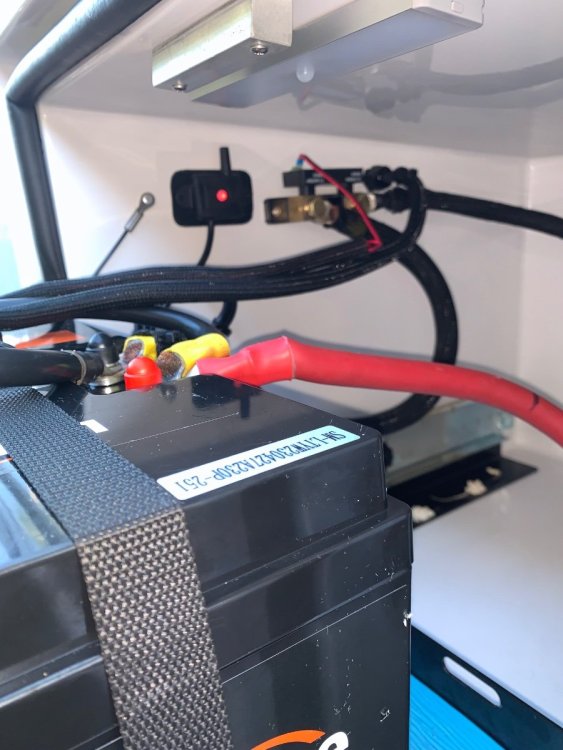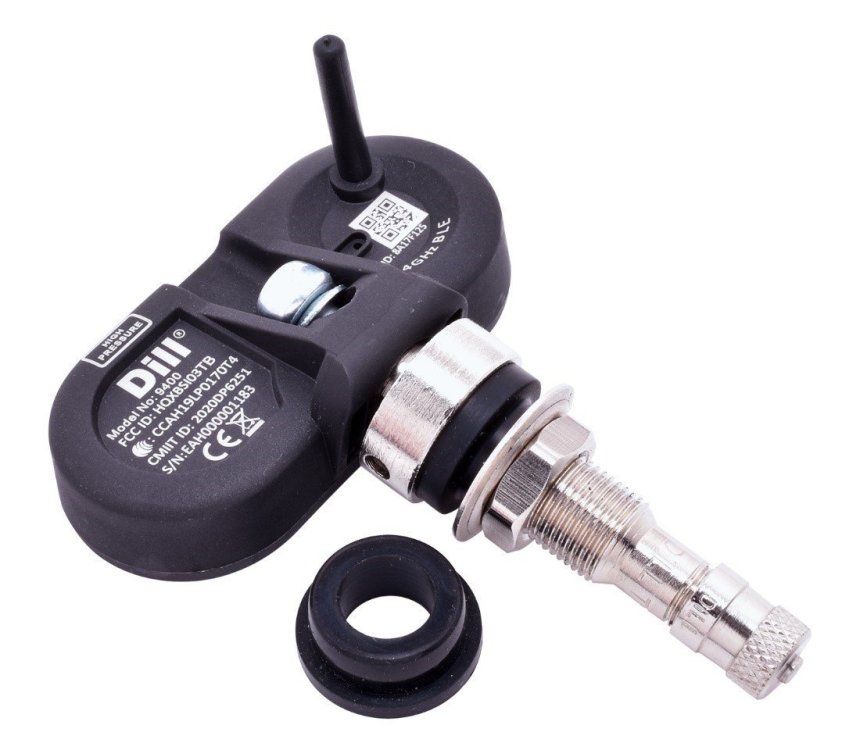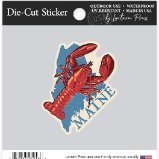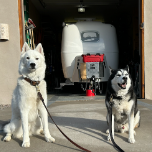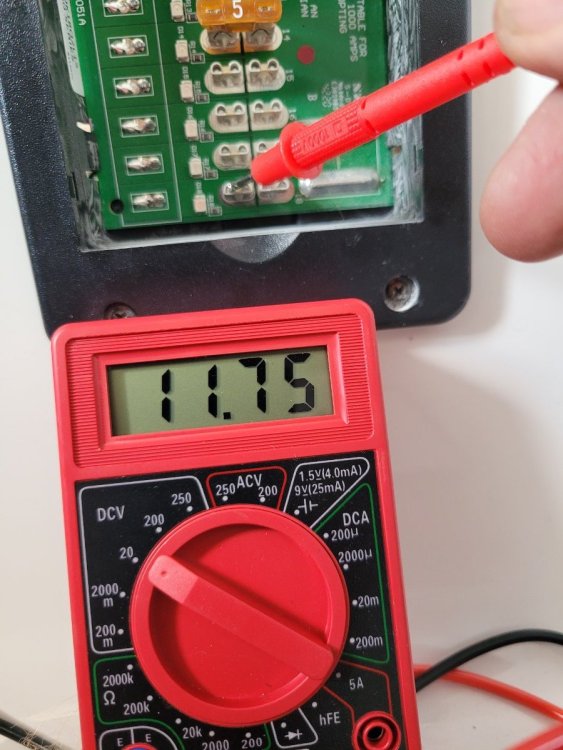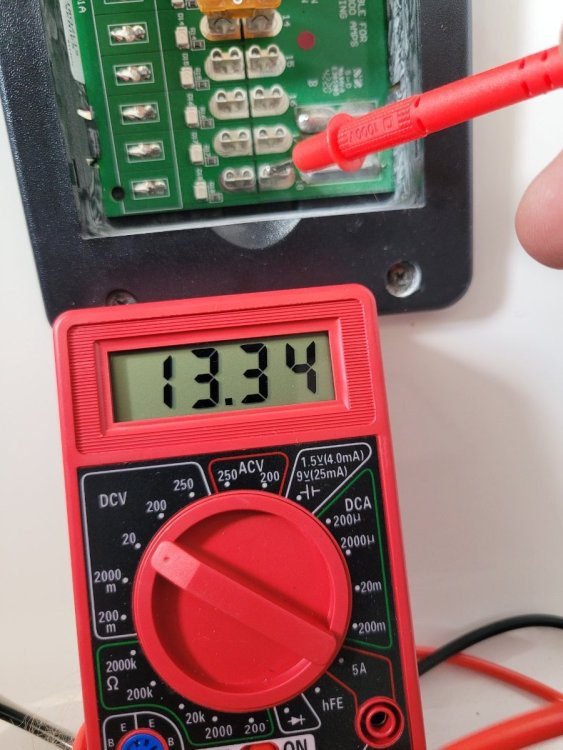Search the Community
Showing results for 'tpms'.
-

Add a Device to the Rear Camera Switch
Ray Kimsey replied to GeoffChapman's topic in Ollie Modifications
I did this, but I connected the TPMS booster in the rear overhead cabinet. I removed the whiteboard on the right to get access to the cables then connected the camera wire with the booster and ground wire to the ground. Worked without a problem. -

Add a Device to the Rear Camera Switch
rich.dev replied to GeoffChapman's topic in Ollie Modifications
Doesn’t answer your question, but I use the TST 507 TPMS and no need for the booster. -
We have had a fast introduction to our new-to-us Elite I (hull 731) since we picked it up over Labor Day weekend in McComb, Ill. We are four years into retirement and felt ready to do some camping and to get out and see more of our country. We thought we could fit camping trips in between our life with our many local grandchildren – and help with visits to our non-local grandchildren. From our home in Pittsburgh, we’ve now taken 5 trips, visited 7 states (from Illinois to NY to Tennessee), travelled 3400 miles and camped for 13 nights. This has given us a deep dive into the Oliver camping world. I thought we’d share our first impressions and ask some questions. Overall, it is evident that the Oliver is a complex and capable trailer. We love it!! We are glad for our purchase and our start into some years (God willing) of camping adventures. The Oliver online forums and the Oliver University have been a goldmine of advice. Thanks to you all, more than once!! As we got started, we had to: · Upgrade our TV capabilities, adding a class 3 hitch, air bags and a brake controller to our 2022 V6 GMC Canyon. All this was new to me, and I’m glad to say we’ve had no towing difficulties. · Learn how to tow. I got my first lessons from our seller at pickup, a *great* guy. Caution and care were important as we started. As of this writing, we’ve been through the Adirondacks and the Smokies at least once. · Learn how to travel with our Cocker. ‘Brecon’ goes with us, almost always. But she does not sleep on our bed, so… the floor by the door proved perfect for her bed, leaving the isle free to walk to the bathroom in the middle of the night. She travels well, and is a sweet companion. · Learn the basic systems, including parking, electrical, propane, solar, water, sewage, heat, and solar. We were told at sale that both our previous owners sold after 1500 miles in part because of the complexity of these units. We sympathize! · Learn the basics of finding places to camp. We studied up on federal, state and private options, including Harvest Hosts and Hipcamp. We quickly concluded that we love remote camping, so we had to learn how to boondock. Hipcamp has been our favorite. · Learn how to live in tight quarters! We’ve been married for 46 good years, but this is a new season. As soon as we had a week of nights or so under our belt, we began to shape our Ollie to fit us. All these mods are reversable, but to date we have: · Swapped out the Furrion rear view camera (with a dim, small, fuzzy image) for a Haloview BT7 1080p Backup Camera. I used the wiring for the Furrion and relocated the camera below the Oliver light, temp caulking the previous Furrion holes. The difference was well worth it. · Taken the TV and its mount out. We don’t use it. · Taken the rail btw the front dinette seat and the rear dinette seat out. The added headroom in sleeping is well worth it. · Added 6 Tireminder TPMS transmitters. I may add 2 more to our spare tires. · Made solar work for at least two or three night stays offgrid. 8 of our first 13 nights were remote (by choice) with no hookups, so we learned to keep electrical use to a minimum, turned off the inverter when off shore-power, and added a 100 watt portable solar panel to our 230 watt rooftop panels. As we sit here and think back on our first weeks with the camper, what have we liked, what do we love? · Without exception, we have enjoyed the people we have met. This country has a lot of great people, many of them living out in the country. · The Oliver has made visiting our large family and other friends a cinch! We happily sleep in our trailer! · We are pleased with the Oliver itself, with its aesthetics, its evident craftsmanship, and its ‘mod-ability’. It fits us well. · We love being warm and snug and dry inside when it is cold and windy and wet outside. · We love waking up to sunrises streaming in the windows. We love going to sleep with night breezes across our faces. We love the hoots of the owls and the barking of the coyotes in the hills. We’ve loved sitting pondside and watching snapping turtles cruise in the evening, the swallows as they dart, and the fish as they leap. · We love the quiet and the calm of the countryside and the hills. · We love the stars deep into the nights in the countryside. We travel with a small telescope and binoculars. The stars have long been a love. Geoff and Becca Chapman
- 5 replies
-
- 13
-

-

-

-
John Davies suggested that I should start a new thread about my Tuson TPMS installation and attach some pictures. The first picture shows the Blue Sea bus bar, 4 fused circuits, that I installed under the dinette seat adjacent to the pantry. This is where the ground bar is located and as far as my power cable from the repeater reached. The repeater is installed under the dinette seat adjacent to the bathroom. Tuson says they want the repeater as far forward as possible and facing a certain direction too. I snaked the cable in the basement under dinette and there is a picture that shows where I installed it. In this picture, you can see the power cable that I ran to the Blue Sea bus bar. It is fused too. The two spares are still attached via a tie wrap and can be see right behind the transfer switch cable. You can see the smaller red power cable connected to the first circuit on the bus bar. If you look closely, you will see that I added a 4 position ground bar which tees with the original ground bar. I removed the screw that Oliver installed to hold the ground bar and replaced with one long enough to account for the thickness of the 4 position ground bar. The next picture shows the Oliver main 12 volt bus bar. The orientation is messed up, but left is down and right is up. This bus bar is located just beyond the fused breaker under the street side bed adjacent to the pantry. The power cable that supplies the bus bar I installed is connected over the positive battery cable that is fed from the fused breaker just visible to the right, but displayed on the bottom of this picture. The third picture is an additional picture of the fused power cable that I installed. Finally, the fourth picture shows the TPMS repeater and I snapped the picture upside down. It is attached with the peel and stick rubber backing. The wire adjacent to it is power for the LED courtesy light on the dinette seat wall adjacent to the aisle. I am not sure how important it is or not, but one of purported benefits of installing the repeater using the battery power is to get readings from the RV batteries while you drive. I am not sure how important that really is, but Tuson really wants me to have the repeater installed due to the overall length of the trailer. The repeater could be installed on the outside because it is waterproof. It only activates, like the TPMS transmitters inside the tires, when the trailer moves, so they are all powered off when the RV is sitting still after a period of time. The LED display is pretty old school, but the functionality seems good. The display can rotate between the tire pressure, tire temperature and battery reading or the preferred screen can be selected. It alarms for low and high pressure and high temperature. Low tire pressure will activate the TPMS sender too without the RV moving which I will test at some point. David Caswell
-
. My TST repeater install, inside the battery box with direct connection to the batteries. No connectivity issues for three years, other than from weak monitor batteries which are easy to replace. I also have monitors on the TV. The ‘early warning’ a TPMS provides is most definitely a preventative measure to lessen the occurrence of a blowout or other catastrophic situation.
-
Tire pressure, tire temps and TPM systems, a few more observations. This might not be the right place to post this so moderators please feel free to move it to another spot if it is inconsistent with the OP's @johnwen post on blowouts. Just returned a couple of weeks ago from a trip to the southwest mostly around San Rafael Reef and Capitol Reef National Park. Weather was all over the place during the tip down, while there and then on the return and thus it became an excellent opportunity to explore the results via the monitor on my new TST TPMS device. As stated above I only have 4 sensors and used them for my TV rather than the Oliver. Earlier in the year I replaced tires on both the TV (F150 Super Crew Cab) as well as the Oliver using Vredestein Pinza AT LT's. Honestly I have mixed emotions regarding putting them on my half ton truck, not because I don't like them but simply because once you start going down this path by default you are re-engineering the suspension system. As all of you know installing LT tires on a vehicle designed for PT tires, inflation rates can change dramatically. In this case tirepressure.com recommended going from the factory setting of 35 PSI all around to 50 PSI all around. Les Schwab stated emphatically to keep them at 35 PSI as the door jamb implies. While this conundrum has not been dealt with to my satisfaction, I decided to run 40 up front and 45 PSI in the rear for the recent trip. FWIW 50 PSI with 10 ply tires installed on a half ton truck with suspension set up for lighter weight 4 ply passenger tires is a brutal ride unless you are on the smoothest of roads. So how did things go? At no time did my tires overheat and pressure only increased by 5-7 PSI depending on a number of factors such as shade, sun exposure, type of driving and so on. Consistently tires facing the sunny side ran warmer and with about 2+ PSI more inflation after warm up, highway speeds tended to level things out while stop and go traffic oddly enough ran tire temps higher. Typically tire temps tended to hover between 8-14 degrees above the ambient outside temperature. At one point driving through stalled SLC traffic tires facing the sun rose to 114 degrees but it was also around 100 degrees outside and no telling what the pavement temps were. So with 40/45 PSI set front and rear respectively at mild temps pressure increased to 45/52 front and rear traveling down the road normally at 65 MPH with a few descents hitting 70 mph. How does one interpret all of this? It tends to fly in the face that one needs to inflate LT tires considerably higher than PT tires for the same vehicle. Clearly the load capacity of each LT tire is not being encountered with my F150, same for the Oliver which incidentally were all inflated to 45 PSI and which were only lightly warm to the touch each time they were checked. There are those who firmly believe in the chalk tire test for proper inflation of LT tires and while I have experimented with this it is not exactly scientific to my way of thinking. Regardless hope this info will be of some help to new comers and veterans alike while out on the road and towing their Olivers. Happy Trails
-
Sounds interesting. The main thing is to have a tpms with the trailer and you're doing that with this new product. 5-7 year battery life sounds great. John
-
I use the EEZTIRE TPMS. But most of these are very similar. The "recommended interval" for changing the batteries is one year. But, I simply leave mine until I start to get a loss of signal notification. Since I always carry spare batteries with me while on the road it is simple to change them. Note that I also remove the wheel sensors and batteries when I am not planning on using my Ollie for a month or so. Even though the sensors should not be transmitting a signal when there isn't movement in the wheel, I feel better knowing that the contacts are not being subjected to humidity, heat, cold, etc. On another note - I have never needed a booster for the EEZTIRE transmitter. However, these signals that are being sent from these small transmitters can experience some loss of signal during very wet weather, snow, and heavy traffic. In addition, depending on the types of things that are being carried in both the tow vehicle an/or the Oliver, signals can be weakened. Bill
-
A TPMS is crucial to have. Check out TST and compare to the one you posted. It comes with a monitor that you can see on your dash and gives you pressure and temperature readings. We have that one and even though we haven't set up the booster, we have no problem getting the measurements from the Oliver LE 2. I have four sensors for the tv and four for the trailer. Tireminder is another brand. John
-
Thank goodness your family and your Oliver is all OK! Years ago, pulling an enclosed cargo tailer from TX to AZ, we had a trailer blowout. Honestly, it's amazing that your OTT and connection to the TV is so solid, that you did not know the blowout even occurred - OMG! Ours was so drastic, that I immediately felt a tug on the truck steering wheel! The belts from the tire tore the fender off completely and it then damaged the siding of the trailer (cheap alum, not our OTT fiberglass). Got a new tire, miles down the desolate dry western highway. Of course, had to park the trailer and run an 85-mile roundtrip with the wheel. I'm going to purchase and install these from Dill. Our truck is 23 years old, so it did not come with TPMS. You can buy a set of 4, or 8 and monitor pressure via Bluetooth to your phone. I will purchase 8 and install inside of my OTT and TV wheels. Dill's new product will be available late October from Tire Rack (first reseller). For truck and trailer you would buy two sets (pat # 1604-V).
-
One advantage of rubber stem mounted sensors: first thing in the morning before departing, make sure your monitor is awake, then walk around and do your tire and wheel inspection, and rap each sensor a couple of times with your finger. This will trigger a new signal to the monitor. As you leave you can see TODAY’S pressures, not yesterday’s!!! If a tire picked up a nail yesterday it could have been slowly deflating all night. Read and learn: https://olivertraveltrailers.com/forums/topic/6043-article-on-how-tpms-sensors-operate/ Turn in your junk wheel without the rubber, and you should get about $14 or $15 for it.. or hang it on your garage wall as a keepsake. I hope you turned in a Service Request about this, maybe a bad batch of tires? Oliver needs to know when these events happen. I am glad the Ollie survived. The rubber scuffs will buff out. John Davies Spokane WA
-
John/Wendy - so happy to hear you are both ok brother! Seems like little damage as well. I see everyone is assisting with their TPMS solutions and I would like to share something a little different that we have used many times on the road to help others. Thankfully, we have not had to use it on our own trailer(s). Anderson levelers makes a "Rapid Jack" and you essentially just roll up on it with your good tire and change your bad tire. Saves all the blocks and jacks that most of us are familiar with. Not trying to "sell" you anything, just for your awareness and anyone who looks at this. Here is a link to their video. Andersen Hitches Rapid Jack Cheers and "Go AIR FORCE"!! Brian
-
I found that my TPMS would alarm without the transmitter after traveling about 1/2 hour. I cut off the alligator clips on the transmitter and sodder on a USB connector onto the wire that I can connect into the Ollie USB connectors. The transmitter, using velcro strips, is located above the dinnete table. Works pretty slick and no more false alarms.
-
@routlaw: Good call, Routlaw IMHO. We invested in a TPMS many years ago which required the pressure/temp sensor batteries to be installed by the factory. That was an earlier system and after 4-5 years, they all needed replacement. Not a cheap date, for sure. Shipping and factory labor was north of $80 at that time. So, after that second set of batts terminated, we didn't want that date again - we found a system that allows the user to replace the sensor batts. This maybe the new standard today - but we just recommend checking about the batt replacement drill before you invest. Either way, a TPMS will give you both a level of confidence and piece of mind especially touring around the Great Southwest in the hot season. Cheers, brother!
-
TPMS is the first thing we install on every trailer. Learned the hard way with trailer #1.
-
Well, that was a PITA. So sorry., but really glad for the persistent motorist who alerted you to the flat tire. We have the TST tpms system. Though we haven't needed the repeater, there is one available to boost the signal forward to the display unit if needed. I think a few other brands sell a booster or repeater, as well.
-
2021 LE2 with the platinum solar package purchased used earlier this year. I was tying into the DC fuse panel to install a TPMS booster and was just double checking voltage before hooking anything up and adding a fuse. Interestedly enough, there is voltage on each leg of the fuse holders. 11.75 volts on each of the unused load side and just over 13 volts on the feed side of the unused ones. Over 13 volts on all the load sides with fuses in. I've owned and worked on campers and boats for many decades and assumed that the load leg shouldn't have any voltage whatsoever until a fuse is plugged in. However, I'm new to the solar game. I've read through the manual a few times and nothing mentioned in there and I've had no problems with the camper so far. The inverter is on and shore power is not hooked up. Might try plugging in and see what happens next. Questions for the collective minds. Is this normal or is something possibly back feeding or causing a problem somewhere?
-
I use the TireTracker TPMS system. Using the instruction manual, I found it very easy to program. My TV already had its own TPMS system so I added only the Ollie to the TireTracker system. For those without a TPMS on their TV, the TireTracker system has enough capability to add both the TV and the Ollie.
-
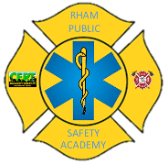
Unidentified wheel noise
Steph and Dud B replied to Steph and Dud B's topic in Mechanical & Technical Tips
P.P.S.: Putting this in writing is helping me process my thoughts. The noise I sometimes hear now from the driver's seat reminds me of the sound manual brakes make when you adjust them until they lightly scrape on the drum. (Unfortunately, I haven't been able to stand next to the trailer while it's happening and Stephanie is less adept at recognizing and describing mechanical noises. If it happens again I need to find a place to get her in the driver's seat so I can hear it myself.) If I'm right, this may be a case of the auto-adjuster making that brake just a little too tight when it clicks up a notch, causing that shoe to drag just a little. On the highway, I'd never hear it and the light drag probably wouldn't heat the drum enough for my TPMS to detect. But it if it happens at low speed I could hear it with the window open. That makes some sense, but it doesn't explain why Steph says it goes "ping" and stops. Unless Steph was hearing the brakes engage as I stopped the vehicle? That would stop the dragging noise. And then when I release the brake it reseats or frees up just enough to stop dragging? Can someone check my logic here? (I really don't like these auto-adjust brakes...) -
In looking over this entire thread due to a recent thread concerning the Garmin rearview camera connected to the Garmin 890, I stumbled across this question and thought that I'd give an update. Until this past summer I had no problem at all with my onboard Ford TPMS for my 2017 F-150. Unfortunately, in August I started getting random dashboard alerts that there was a TPMS "malfunction" with my front passenger side wheel. Several times I checked my tire pressures and each time the pressures were correct (i.e. they didn't change at all!). I did remember this thread and thought about the placement of the Garmin (plus my InReach mini and/or sometimes a cell phone) as possibly being a contributing factor. Finally, when I recently took the truck into the dealer for an oil change I asked the service tech to rotate the tires and have a look at that TPMS in the front left closely due to this random fault. Bottom line is that there was a small nail in the thread of the tire that was not long enough to puncture the tire. According to the tech - since this nail was relatively close to where the TPMS is mounted in the tire, the nail was interfering with the data transmission from the tire to the receiving unit inside the truck. I have to admit that I was a bit suspect of this explanation but its now been over a month since and there have been no further TPMS "malfunctions" and the tire pressure continue to remain stable. Bill
-
Wondering if any of you who have used the Tire Tracker TT-600 as a pressure monitoring system have found it necessary to use the signal booster? I seem to lose signal after an hour or two of driving for some reason....
-
Researching TV and trailer purchase. Ford has a rear view trailer camera that will sinc with its monitor inside the truck. It is a hard wire unit. I was thinking I could send the unit to Oliver and have them run the wires inside when they build the trailer. They said they could do this for an additional fee. Was wondering if anyone has done this? I understand the unit will only work while the truck is in reverse. Don't understand why that is, or if I like the idea. Seem like one might want to take a peak while go down the road. However, maybe not a big deal. I don't know if the camera that Oliver offers as an option works all the time. But it does require a separate monitor. I like the idea of only one screen but not the fact it only works in reverse. Does anyone have any thoughts on this? Also, Ford offers a TPMS unit that works with it's monitor. However, I read that the valves don't fit on all rims. Can you get adapters that will make the valve work? Or purchase another brand that fits the Oliver rim? But, will it work with the Ford software? Has anyone experienced this problem? Probably a question for Oliver service. Geeez, somethings are not easy. Maybe just a pocket tire gauge and one of those oval mirrors like the mail trucks have. Thanks for your thoughts!
-
Many of the newer tow vehicles are able to monitor trailer TPMS on the dash with the truck's tires simultaneously. Our F350 was ordered with the trailer TPMS package. Once the Ollie arrives, I will install and program them to the truck for a full view of all tires. With the change to 5200# axles on the 2023 LE2's, they have switched back to 15" ST tires from the factory. I'm okay with it. The key to ST's or any tire for that matter is stay away from the Chinese knock off tire bombs and watch your pressures. Also a lot of RV trailers run very close if not over the load ratings of the supplied tires and axles once loaded for the road. Oliver doesn't have that problem.
-
TPMS is just as important to me as any other option we have. Don't some of the newer trucks allow you to add sensors to your trailer that are read and displayed by the factory TPMS? My old Tundra does not, so we use a TST system. Worked great to/from Alaska. Fortunately, we never had any issues with the truck or Ollie tires. I know the LT versus ST arguments have been made previously, but the factory Cooper tires have done much better than I expected. Would have preferred the previous years Michelins and I wouldn't hesitate to install high quality LT tires again.











